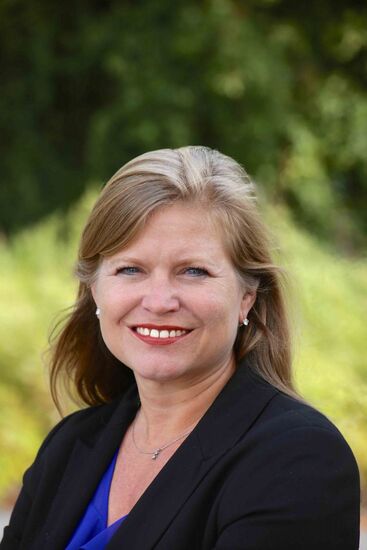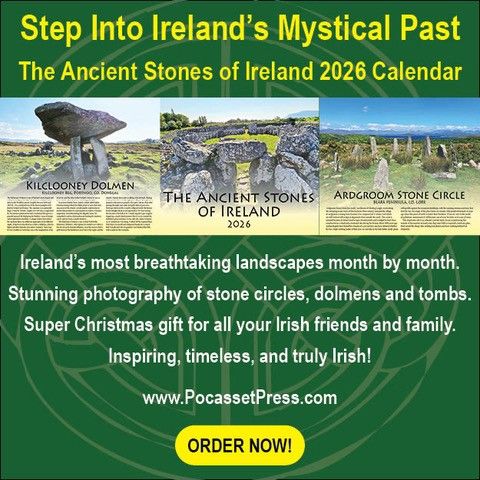Hilary Mhic Suibhne.
Page Turner / Edited by Peter McDermott
Bilingualism was where it was at in 18th and 19th century Ireland – at least when it came to verbal one-upmanship.
That was just one phenomenon discussed at a 2014 conference, the first in Irish held outside of Ireland, at New York University entitled “Humor and the Irish Language” and which subsequently became the basis of a special issue of the American Journal of Irish Studies
“Humorous sayings and stories of the 18th and early 19th centuries often focused on the power of bilingual speakers,” said conference organizer and issue editor Hilary Mhic Suibhne, who is a language lecturer at Glucksman Ireland House, NYU.
Fun could be made at the expense of someone who spoke only Irish or only English. Either was fair target for mockery.
“There was no glorifying of the monolingual Irish speaker,” Mhic Suibhne said, “nonetheless English was often considered inferior.
“Many examples are found in ‘An Irish-Speaking Island’ [2014], by Nicholas Wolf,” Mhic Suibhne said. (Here’s one, an exchange between a police constable, or Peeler, who has no Irish and a local who has no English: "Fine day," remarks the Peeler, prompting the Irish speaker, who mistakes the English word "day" for the Irish ‘tae’ [tea], to answer in Irish, "Hell if I know where you can get some tea!")
“Pretending to only understand Irish when one was bilingual could also lead to humorous misunderstandings,” she added.
The former director of Glucksman Ireland House Professor Joe Lee describes the special issue of the American Journal of Irish Studies in its forward as a “serious book about humor,” adding that the successful conference and the volume grew from the “vision and persistence of Hilary Mhic Suibhne.”

Hilary Mhic Suibhne
Place of birth: Limerick
Spouse: Páraic Sweeney
Children: 3 sons.
Residence: North Salem, N.Y.
Published works:
“American Journal of Irish Studies.” Eagrán Gaeilge. Bilingual Edition. Volume 13. Hilary Mhic Suibhne (Ed.) (Glucksman Ireland House. New York University. 2016)
“Súil Siar: Essays by Barra Ó Donnabháin,” edited and translated by Hilary Mhic Suibhne and Eibhlín Zurell. Bilingual. (Daltaí na Gaeilge. 2008).
“Zeitgeist na Gaeilge,” In Taighde agus Teagasc na Gaeilge i Meiriceá Thuaidh, Ed. Sheila Scott, Aralt Mac Giolla Chainnigh, Sailí Ní Dhroighneáin, (Dalhousie University, Halifax, Nova Scotia. 2015).
“Pasture to Pavement: Working Class Irish and Urban Workhorses in Nineteenth Century New York City” American Journal of Irish Studies., Vol 11 (2014) pp. 125-152.
Articles in: the Irish Echo. Iris Comhar. The Journal of Celtic Language Learning. An Gael. Irish Language Blog: HilaryNY.blogspot.com.
What is your writing routine? Are there ideal conditions?
I wish I had one! I don't believe that there are ideal conditions which can be universally applied. But if I'm going to write at all it will be early in the morning, unfortunately it's easy to procrastinate.
What advice do you have for aspiring writers?
One has to be courageous as there will be criticism of your work and your opinions which can be disheartening and interfere with your focus.
Name three books that are memorable in terms of your reading pleasure.
Three is a very small number and as I read in both Irish and English this will be difficult, I will limit myself to English. Reading pleasure changes with the passage of time, books can be reread at different phases in one's life leading to different types of engagement. The first book that made a lasting impression on me as a very young adult was “To Kill a Mockingbird” by Harper Lee. Before that I was basically reading children's adventure stories but “Mockingbird” revealed a new world of pleasure, with thought-provoking questions and education rolled into one. Much more recently I found “A Pale View of Hills” by Kazuo Ishiguro to be an extraordinary book. Ishiguro's command of the inner world of his characters through exquisite uncomplicated prose is such a pleasure to read. He simultaneously controls his reader's understanding of delusion, a skill he also put to good effect in his novel “The Remains of The Day.” My third choice is “A Suitable Boy” by Vikram Seth for an unusual reason. I read it shortly after having moved to New York. On a sunny spring morning as I sat outside my new home engrossed in this captivating novel I was joined by a friendly yellow Labrador. His owner, my next-door neighbor, arrived to retrieve him and as she introduced herself she noticed my book, she had recently read a review of it in the New York Times. Our discussion that morning lead shortly thereafter to the establishment of a book group, still in existence after over 20 years and many, many books. Therefore, undoubtedly “A Suitable Boy” ranks highly as a book which has lead directly and indirectly to much reading pleasure.
What book are you currently reading?
I'm currently engrossed in Tana French's new book “The Witch Elm.” I've just started it and so far it seems to be an interesting departure from her other books.
Name a book that you were pleasantly surprised by.
“Americanah” by Chimamanda Ngozi Adichie is a fascinating story of race and identity by a Nigerian writer based in the United States. It is beautifully written and fully captures the sometimes humorous condition of an immigrant or naturalized American like me.
If you could meet one author, living or dead, who would it be?
A cup of tea with Sebastian Barry would be lovely, I think it would be in front of the fire in my living room on a winter afternoon. We'd probably talk about the weather.
What is your favorite spot in Ireland?
Erris Peninsula and Corca Dhuibhne share this award.
You're Irish if…
you know what “at high doh” means.
Email: ireland.house@nyu.edu; website: www.irelandhouse.fas.nyu.edu.
‘Pasture to Pavement'
Hilary Mhic Suibhne will give a presentation, “Pasture to Pavement: Parallels and intersections in the lives of working-class Irish and urban work horses in 19th century New York City,” on Sunday, May 5 (from 2-4 p.m.) at the Gaelic American Club, Fairfield, Conn.
This talk will trace the role of horses in Irish culture, and how the lives of the living four-legged machines of New York City and those of poor Irish immigrants whose labor was central to the development of the city, revolved around one other.
“It’s based on my research into Antebellum New York City,” said Mhic Suibhne, a language lecturer at Glucksman House, NYU, “where I focused on Irish workers living in the Five Points.”
The event is sponsored by Fréamh Éireann, the genealogy group of the Gaelic American Club.








